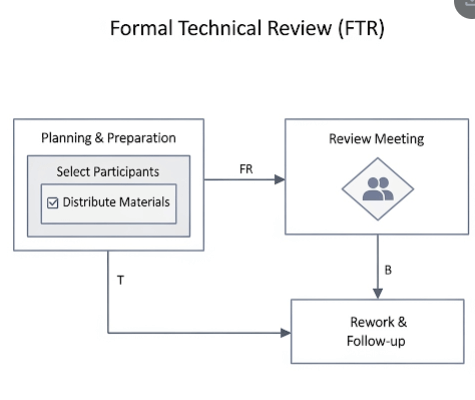- Metrics for Process and Products
- Software measurement
- Metrics for Software Quality
- Risk Management
- Reactive versus Proactive Risk Strategies
- Software Risks
- Risk Identification
- Risk Projection
- Risk Refinement
- RMMM
- RMMM Plan
- Quality Management
- Quality Concepts
- Software Reviews
- Formal Technical Reviews
- Statistical Software Quality Assurance
- Software Reliability
- The ISO 9000 Quality Standards
Introduction to Formal Technical Reviews
In software engineering, Formal Technical Reviews (FTRs) are a highly structured and systematic type of software review. These are formal meetings involving a team of peers who meticulously examine a software engineering work product – such as requirements specifications, design documents, or source code – to identify defects. The primary objective of FTRs is to uncover errors as early as possible in the development lifecycle, preventing them from propagating to later stages where they become significantly more costly to fix. By adhering to defined procedures and roles, FTRs are a powerful mechanism for enhancing software quality and reliability.
Objectives of Formal Technical Reviews
The specific objectives of Formal Technical Reviews are designed to maximize their effectiveness in improving software quality:
- Uncover Errors (Defects): The foremost objective is to find as many errors as possible in the work product being reviewed. This includes logical errors, factual errors, omissions, inconsistencies, and deviations from standards.
- Verify Conformance to Standards: FTRs ensure that the software artifact adheres to predefined standards, guidelines, and specifications (e.g., coding standards, design principles, documentation guidelines).
- Improve Product Quality: By detecting and removing defects early, FTRs directly contribute to a higher quality software product, reducing rework and post-release issues.
- Achieve Uniformity: They help in maintaining consistency across different parts of the software and among different developers, by enforcing common practices and interpretations.
- Reduce Future Effort: Identifying errors early means less effort will be required in later phases like testing and maintenance, leading to overall cost and time savings.
- Enable Technical Training: Reviewers often gain valuable technical knowledge and insights by examining the work of others, promoting skills development within the team.
The Formal Technical Review Process
Formal Technical Reviews typically follow a well-defined process to ensure their effectiveness and efficiency. The process involves several distinct phases:
1. Planning and Preparation
- Select Participants: A small team (typically 3-5 people) is chosen, including a moderator, the producer (author of the work product), and 1-3 reviewers. Each participant has a defined role.
- Define Scope: The specific section of the work product to be reviewed is clearly identified.
- Distribute Materials: All participants receive the work product, relevant standards, and checklists well in advance of the meeting.
- Individual Preparation: Reviewers independently examine the material, noting any potential defects or questions. This individual effort is crucial.
2. The Review Meeting
- Structured Session: The meeting is led by a moderator and follows a strict agenda. It is usually kept to a manageable length (e.g., 1-2 hours).
- Producer’s Presentation (Optional): The producer may briefly walk through the work product to provide context, but the focus quickly shifts to defect identification.
- Error Identification: Reviewers present the errors they found during their individual preparation. The team collaboratively identifies and logs additional errors.
- No Problem Solving: It is critical that the meeting focuses solely on identifying errors, not on debating solutions or fixing the defects. Solutions are handled offline by the producer.
- Recorder’s Role: A designated recorder documents all identified defects, questions, and action items.
3. Rework and Follow-up
- Producer’s Rework: The producer is responsible for addressing all identified defects and making necessary corrections to the work product after the meeting.
- Verification: The moderator or a designated reviewer verifies that all defects have been properly addressed. This is a critical step to ensure the review’s effectiveness.
- Sign-off: Once all defects are resolved and verified, the review process is formally concluded.

Key Roles in FTRs
Successful Formal Technical Reviews rely on distinct roles and responsibilities:
- Producer (Author): The individual who created the work product being reviewed. Their role is to provide context and clarify points, and later to address the identified defects.
- Moderator: The facilitator of the FTR meeting. The moderator ensures the meeting stays on track, enforces the rules, keeps participants focused on defect finding, and manages time.
- Reviewers: The individuals who examine the work product, identify defects, and offer constructive feedback. They are typically peers or subject matter experts.
- Recorder (Scribe): The person responsible for documenting all defects identified during the meeting, as well as any action items or follow-up tasks.
Benefits of Formal Technical Reviews
Implementing Formal Technical Reviews offers significant advantages for software development projects:
- Early Defect Removal: FTRs are highly effective at finding errors early in the lifecycle, before they become expensive.
- Improved Software Quality: They directly lead to more reliable, robust, and maintainable software.
- Cost Reduction: The cost of fixing defects found in reviews is substantially lower than fixing them in later phases like testing or after deployment.
- Knowledge Transfer and Training: Reviewers learn from each other and gain deeper insights into the project and coding standards.
- Enhanced Team Collaboration: The peer review process fosters communication and a shared understanding of quality goals.
- Adherence to Standards: FTRs reinforce the application of established engineering standards and guidelines.
Conclusion
Formal Technical Reviews (FTRs) are a cornerstone of effective software quality assurance. By employing a structured, systematic, and peer-driven approach to examining software work products, FTRs are exceptionally effective at identifying and removing defects early in the development lifecycle. Their defined objectives, meticulous process, and clear roles contribute significantly to enhancing software quality, reducing development costs, and fostering a culture of excellence in software engineering. Implementing robust FTRs is a hallmark of mature software development practices.
